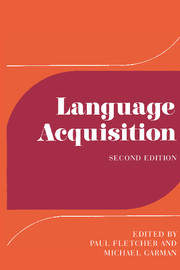Book contents
- Frontmatter
- Contents
- Contributors
- Preface
- Part I Contexts and determinants
- Part II The development of linguistic systems: phonology
- Introduction
- 7 Prespeech segmental feature development
- 8 Prosodic development
- 9 Early strategies for the perception and production of words and sounds
- 10 Phonological development: production
- 11 Speech perception and the emergent lexicon: an ethological approach
- 12 Phonological development: a crosslinguistic perspective
- Part III The development of linguistic systems: grammar
- Part IV Later language development
- Notes to chapters
- Bibliography and citation index
- General index
- Titles in the series
8 - Prosodic development
Published online by Cambridge University Press: 05 June 2012
- Frontmatter
- Contents
- Contributors
- Preface
- Part I Contexts and determinants
- Part II The development of linguistic systems: phonology
- Introduction
- 7 Prespeech segmental feature development
- 8 Prosodic development
- 9 Early strategies for the perception and production of words and sounds
- 10 Phonological development: production
- 11 Speech perception and the emergent lexicon: an ethological approach
- 12 Phonological development: a crosslinguistic perspective
- Part III The development of linguistic systems: grammar
- Part IV Later language development
- Notes to chapters
- Bibliography and citation index
- General index
- Titles in the series
Summary
The nature of prosody
Unlike the well-established fields of grammar and segmental phonology, the field of prosody requires a certain amount of exposition before one can talk about its development in children. What range of data is to be subsumed under this heading? For present purposes, it will be useful to select three main themes from the prosodic literature, reviewed, for example, in Crystal (1969, 1975): (a) What is excluded from the domain of a prosodic theory? (b) What variations in prosodic form may be identified? (c) What range of prosodic functions may be established?
The first question may be answered briefly, as its purpose is solely to relate prosody to other areas with which it is often confused. Given a specification of semiotic behaviour as ‘patterned human communication in all its modes’ (Sebeok, Hayes and Bateson 1964), then prosodic features can be identified as one component of the auditory–vocal dimension of communication, i.e. excluding the visual (‘kinetic’), tactile (‘proxemic’) and other communicative modes referred to globally under the general heading of ‘nonverbal communication’ (see Argyle 1975). Within the auditory–vocal area, a distinction is conventionally made between segmental and nonsegmental phonology, the latter usually being defined as the ‘residue’ of the former – what is left after one has studied the vowel/consonant/syllabic system of sounds.
- Type
- Chapter
- Information
- Language AcquisitionStudies in First Language Development, pp. 174 - 197Publisher: Cambridge University PressPrint publication year: 1986
- 33
- Cited by

